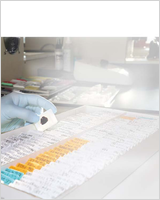NCBI Bookshelf. A service of the National Library of Medicine, National Institutes of Health.
Abstract
Biobanking has developed at a rapid pace in recent years, initiated by the drive for personalized medicine, the need for high-quality biological resources and associated data for scientific research, and technological advancement of analytical platforms for molecular and genetic research.
This book includes guidelines and recommendations for biobanks not only in high-income countries but also in low- and middle-income countries (LMICs). The recommendations are based on validated and/or evidence-based guidelines.
The book also includes sections on sample sharing, ethical, legal, and social issues (ELSI), and harmonization guidelines important to support collaborative research efforts that make use of biological materials. In particular, the section on open access deals with the principles of sharing and provides recommendations for biobanks in relation to sample and data sharing, which is key to establishing research collaboration. The section on governance provides guidelines on governance structures and standard templates for biobanks for a transparent and effective running of the facilities.
This book also benefits from the experience and knowledge gained by IARC from coordinating the LMICs Biobank and Cohort Building Network (BCNet) and managing an international biobank, which contains diverse collections of specimens and data drawn from studies across the world, including the EPIC (European Prospective Investigation into Cancer and Nutrition) collection.
Contents
- Library Cataloguing Information
- Contributors
- Acknowledgements
- Foreword
- Preamble
- Abbreviations
- SECTION 1. Glossary and definitions
- Adverse event
- Aliquot
- Analyte
- Annotation
- Anomaly
- Anonymization
- Associated data
- Autopsy
- Biobank
- Biobanking
- Biohazard
- Biological resource
- Biological safety hood
- Biorepository
- Coding
- Cold chain
- Cold ischaemia
- Collection
- Consignee
- Container
- Controlled areas
- Custodian
- Database
- Dehydration
- De-identification
- Desiccant
- Deviation
- Dewar
- Distribution
- Donor
- Dry ice
- End user
- Ergonomics
- Error
- Ethical, legal, and social issues (ELSI)
- Identifier
- Incident
- Individual
- Informed consent
- Institution
- Institutional review board (IRB)
- Label
- Liquid nitrogen (LN2)
- Liquid nitrogen tank
- Lyophilized
- Material Transfer Agreement (MTA)/Data Transfer Agreement (DTA)
- Monitoring system
- Participant
- Patient
- Pre-analytical data
- Preservation
- Procedure
- Processing
- Pseudo-anonymization
- Quality
- Quality assurance (QA)
- Quality control (QC)
- Quality management system (QMS)
- Re-identification
- Removal
- Repository
- Research ethics committee (REC)
- Retrieval
- Safety
- Sample
- Shipping manifest
- Snap-freezing
- Specimen
- Standard operating procedures (SOPs)
- Storage
- Subject
- Traceability
- Warm ischaemia
- SECTION 2. Role of biobanks in cancer research
- SECTION 3. Recommendations for biobanks
- 3.1. Ethical, legal, and social issues (ELSI) and governance
- 3.2. General safety precautions required for working in a biobank
- 3.3. Infrastructure and storage facilities
- 3.4. Quality
- 3.5. Contents of standard operating procedures (SOPs)
- 3.6. Records management
- 3.7. Specimen collection, processing, and storage
- 3.8. Specimen annotations and data sets
- 3.9. Specimen shipping
- 3.10. Biobank workflow
- SECTION 4. Selected protocols
- References
- ANNEX 1. IARC policy on access to human biological materials
- ANNEX 2. Guidelines for informed consent
- ANNEX 3. Template consent form for biobanking
- ANNEX 4. Template Material/Data Transfer Agreement (MTA/DTA)
- ANNEX 5. Biobank, collection, study, and sample minimum data set and associated standard available
- Disclosures of interests
About the Series
- NLM CatalogRelated NLM Catalog Entries
- Review A Review of Regulatory Frameworks Governing Biobanking in the Low and Middle Income Member Countries of BCNet.[Biopreserv Biobank. 2021]Review A Review of Regulatory Frameworks Governing Biobanking in the Low and Middle Income Member Countries of BCNet.Vodosin P, Jorgensen AK, Mendy M, Kozlakidis Z, Caboux E, Zawati MH. Biopreserv Biobank. 2021 Oct; 19(5):444-452. Epub 2021 May 3.
- Role of a regulatory and governance framework in human biological materials and data sharing in National Biobanks: Case studies from Biobank Integrating Platform, Taiwan and the National Biorepository, Uganda.[Wellcome Open Res. 2019]Role of a regulatory and governance framework in human biological materials and data sharing in National Biobanks: Case studies from Biobank Integrating Platform, Taiwan and the National Biorepository, Uganda.Nansumba H, Ssewanyana I, Tai M, Wassenaar D. Wellcome Open Res. 2019; 4:171. Epub 2020 Sep 1.
- Ethical navigation of biobanking establishment in Ukraine: learning from the experience of developing countries.[J Med Ethics. 2023]Ethical navigation of biobanking establishment in Ukraine: learning from the experience of developing countries.Sulaieva ON, Artamonova O, Dudin O, Semikov R, Urakov D, Zakharash Y, Kacharian A, Strilka V, Mykhalchuk I, Haidamak O, et al. J Med Ethics. 2023 Nov 9; . Epub 2023 Nov 9.
- Infrastructure and facilities for human biobanking in low- and middle-income countries: a situation analysis.[Pathobiology. 2014]Infrastructure and facilities for human biobanking in low- and middle-income countries: a situation analysis.Mendy M, Caboux E, Sylla BS, Dillner J, Chinquee J, Wild C, BCNet survey participants. Pathobiology. 2014; 81(5-6):252-260. Epub 2015 Mar 16.
- Review Population biobanking and international collaboration.[Pathobiology. 2014]Review Population biobanking and international collaboration.Zawati MH, Knoppers B, Thorogood A. Pathobiology. 2014; 81(5-6):276-285. Epub 2015 Mar 16.
- Common Minimum Technical Standards and Protocols for Biobanks Dedicated to Cance...Common Minimum Technical Standards and Protocols for Biobanks Dedicated to Cancer Research
Your browsing activity is empty.
Activity recording is turned off.
See more...
